Abstract
OBJECTIVE: Surgical wound infections remain a significant source of postoperative morbidity. This study was undertaken to determine prospectively the incidence of postoperative wound infections in children in a multi-institutional fashion and to identify the risk factors associated with the development of a wound infection in this population. SUMMARY BACKGROUND DATA: Despite a large body of literature in adults, there have been only two reports from North America concerning postoperative wound infections in children. METHODS: All infants and children undergoing operation on the pediatric surgical services of three institutions during a 17-month period were prospectively followed for 30 days after surgery for the development of a wound infection. RESULTS: A total of 846 of 1021 patients were followed for 30 days. The overall incidence of wound infection was 4.4%. Factors found to be significantly associated with a postoperative wound infection were the amount of contamination at operation (p = 0.006) and the duration of the operation (p = 0.03). Comparing children who developed a wound infection with those who did not, there were no significant differences in age, sex, American Society of Anesthesiologists (ASA) preoperative assessment score, length of preoperative hospitalization, location of operation (intensive care unit vs. operating room), presence of a coexisting disease or remote infection, or the use of perioperative antibiotics. CONCLUSIONS: Our results suggest that wound infections in children are related more to the factors at operation than to the overall physiologic status. Procedures can be performed in the intensive care unit without any increase in the incidence of wound infection.
Full text
PDF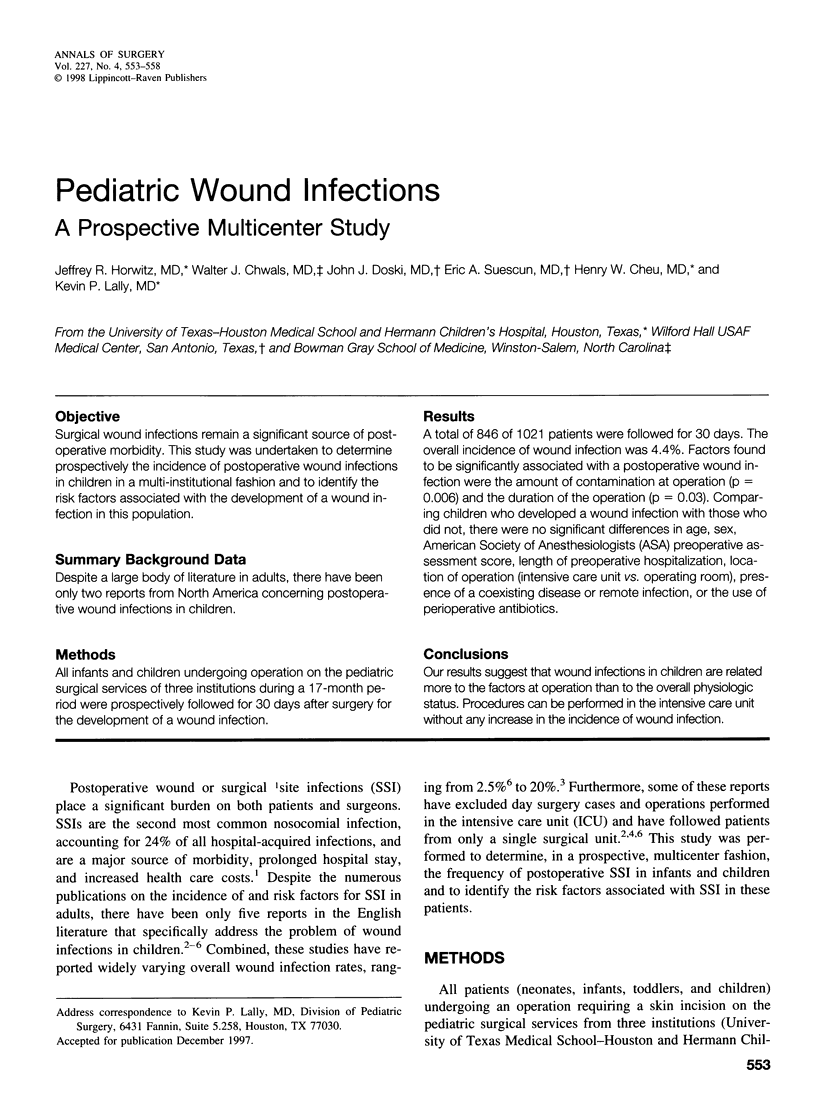
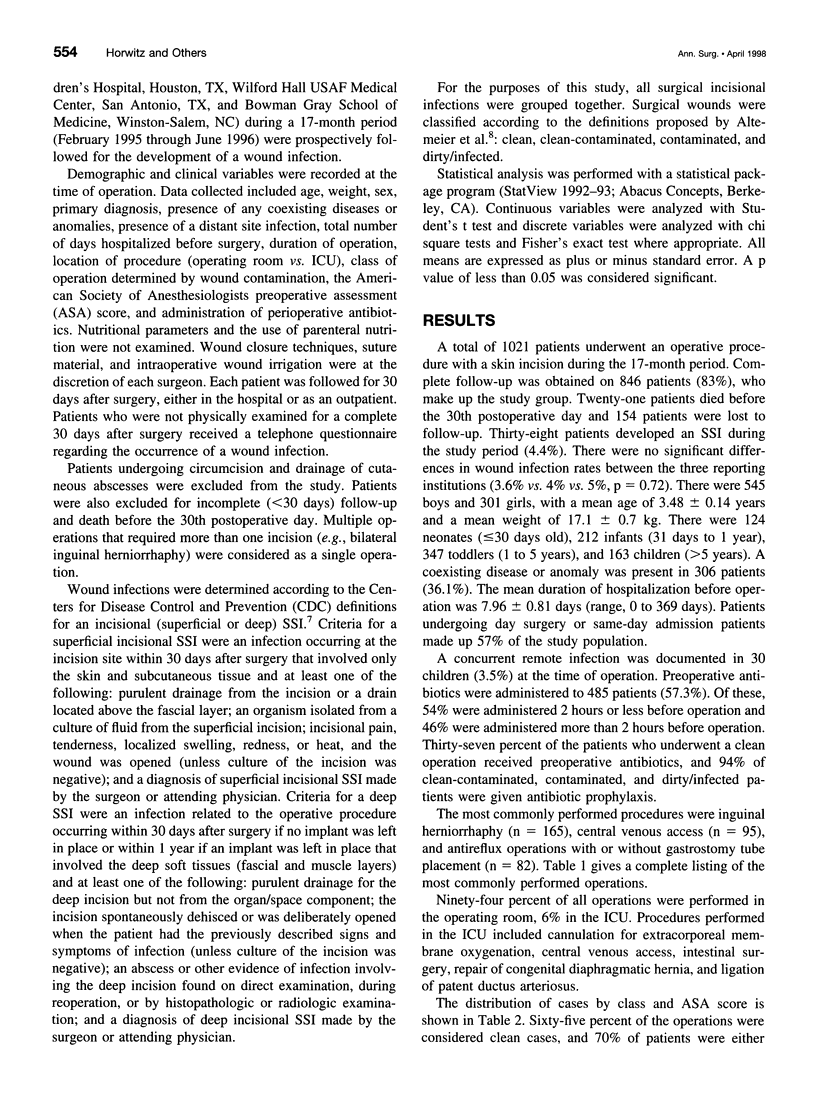
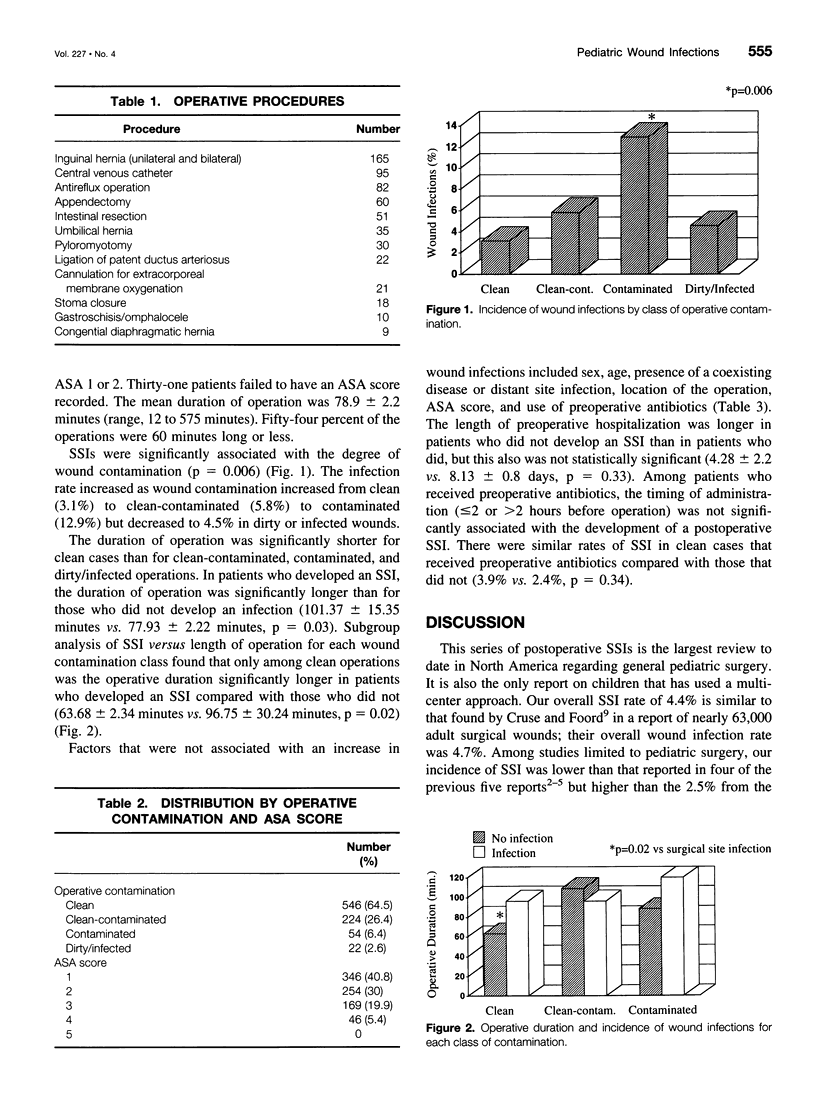

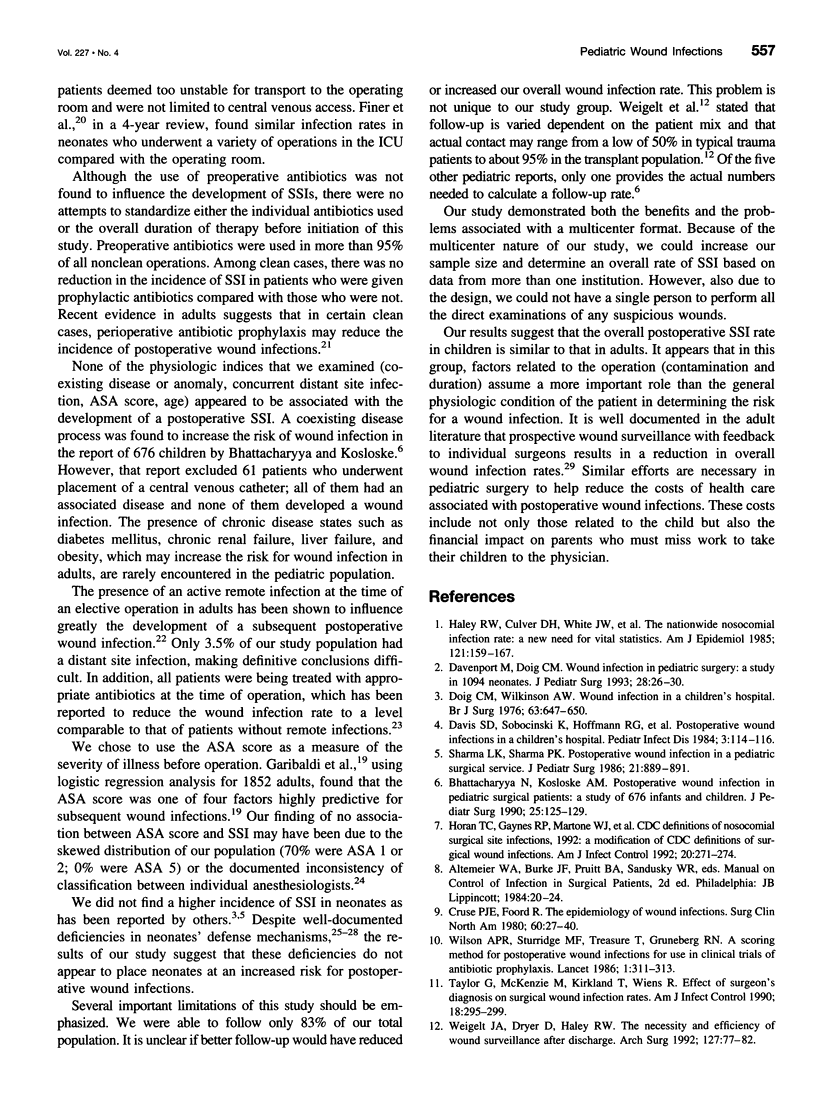
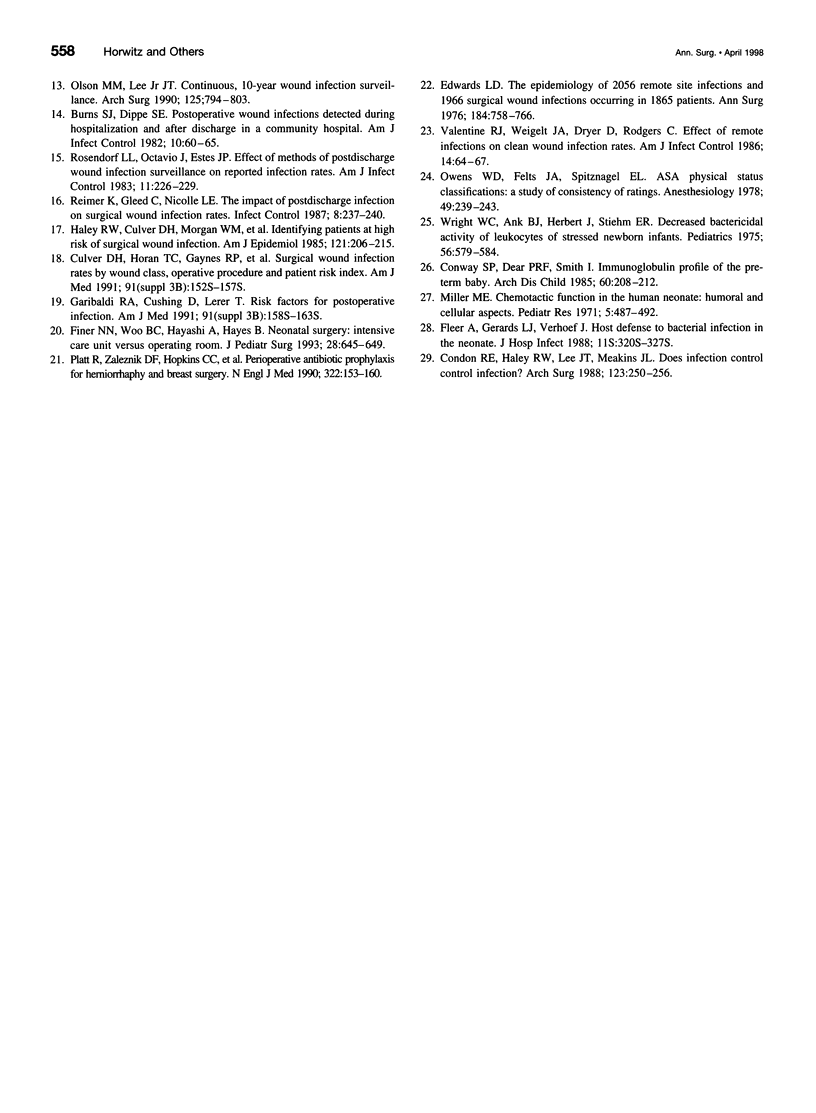
Selected References
These references are in PubMed. This may not be the complete list of references from this article.
- Bhattacharyya N., Kosloske A. M. Postoperative wound infection in pediatric surgical patients: a study of 676 infants and children. J Pediatr Surg. 1990 Jan;25(1):125–129. doi: 10.1016/s0022-3468(05)80177-0. [DOI] [PubMed] [Google Scholar]
- Burns S. J., Dippe S. E. Postoperative wound infections detected during hospitalization and after discharge in a community hospital. Am J Infect Control. 1982 May;10(2):60–65. [PubMed] [Google Scholar]
- Condon R. E., Haley R. W., Lee J. T., Jr, Meakins J. L. Does infection control control infection? Arch Surg. 1988 Feb;123(2):250–256. doi: 10.1001/archsurg.1988.01400260138019. [DOI] [PubMed] [Google Scholar]
- Conway S. P., Dear P. R., Smith I. Immunoglobulin profile of the preterm baby. Arch Dis Child. 1985 Mar;60(3):208–212. doi: 10.1136/adc.60.3.208. [DOI] [PMC free article] [PubMed] [Google Scholar]
- Cruse P. J., Foord R. The epidemiology of wound infection. A 10-year prospective study of 62,939 wounds. Surg Clin North Am. 1980 Feb;60(1):27–40. doi: 10.1016/s0039-6109(16)42031-1. [DOI] [PubMed] [Google Scholar]
- Culver D. H., Horan T. C., Gaynes R. P., Martone W. J., Jarvis W. R., Emori T. G., Banerjee S. N., Edwards J. R., Tolson J. S., Henderson T. S. Surgical wound infection rates by wound class, operative procedure, and patient risk index. National Nosocomial Infections Surveillance System. Am J Med. 1991 Sep 16;91(3B):152S–157S. doi: 10.1016/0002-9343(91)90361-z. [DOI] [PubMed] [Google Scholar]
- Davenport M., Doig C. M. Wound infection in pediatric surgery: a study in 1,094 neonates. J Pediatr Surg. 1993 Jan;28(1):26–30. doi: 10.1016/s0022-3468(05)80348-3. [DOI] [PubMed] [Google Scholar]
- Davis S. D., Sobocinski K., Hoffmann R. G., Mohr B., Nelson D. B. Postoperative wound infections in a children's hospital. Pediatr Infect Dis. 1984 Mar-Apr;3(2):114–116. doi: 10.1097/00006454-198403000-00006. [DOI] [PubMed] [Google Scholar]
- Doig C. M., Wilkinson A. W. Wound infection in a children's hospital. Br J Surg. 1976 Aug;63(8):647–650. doi: 10.1002/bjs.1800630822. [DOI] [PubMed] [Google Scholar]
- Edwards L. D. The epidemiology of 2056 remote site infections and 1966 surgical wound infections occurring in 1865 patients: a four year study of 40,923 operations at Rush-Presbyterian-St. Luke's Hospital, Chicago. Ann Surg. 1976 Dec;184(6):758–766. doi: 10.1097/00000658-197612000-00017. [DOI] [PMC free article] [PubMed] [Google Scholar]
- Finer N. N., Woo B. C., Hayashi A., Hayes B. Neonatal surgery: intensive care unit versus operating room. J Pediatr Surg. 1993 May;28(5):645–649. doi: 10.1016/0022-3468(93)90021-c. [DOI] [PubMed] [Google Scholar]
- Garibaldi R. A., Cushing D., Lerer T. Risk factors for postoperative infection. Am J Med. 1991 Sep 16;91(3B):158S–163S. doi: 10.1016/0002-9343(91)90362-2. [DOI] [PubMed] [Google Scholar]
- Haley R. W., Culver D. H., Morgan W. M., White J. W., Emori T. G., Hooton T. M. Identifying patients at high risk of surgical wound infection. A simple multivariate index of patient susceptibility and wound contamination. Am J Epidemiol. 1985 Feb;121(2):206–215. doi: 10.1093/oxfordjournals.aje.a113991. [DOI] [PubMed] [Google Scholar]
- Haley R. W., Culver D. H., White J. W., Morgan W. M., Emori T. G. The nationwide nosocomial infection rate. A new need for vital statistics. Am J Epidemiol. 1985 Feb;121(2):159–167. doi: 10.1093/oxfordjournals.aje.a113988. [DOI] [PubMed] [Google Scholar]
- Horan T. C., Gaynes R. P., Martone W. J., Jarvis W. R., Emori T. G. CDC definitions of nosocomial surgical site infections, 1992: a modification of CDC definitions of surgical wound infections. Am J Infect Control. 1992 Oct;20(5):271–274. doi: 10.1016/s0196-6553(05)80201-9. [DOI] [PubMed] [Google Scholar]
- Olson M. M., Lee J. T., Jr Continuous, 10-year wound infection surveillance. Results, advantages, and unanswered questions. Arch Surg. 1990 Jun;125(6):794–803. doi: 10.1001/archsurg.1990.01410180120020. [DOI] [PubMed] [Google Scholar]
- Owens W. D., Felts J. A., Spitznagel E. L., Jr ASA physical status classifications: a study of consistency of ratings. Anesthesiology. 1978 Oct;49(4):239–243. doi: 10.1097/00000542-197810000-00003. [DOI] [PubMed] [Google Scholar]
- Platt R., Zaleznik D. F., Hopkins C. C., Dellinger E. P., Karchmer A. W., Bryan C. S., Burke J. F., Wikler M. A., Marino S. K., Holbrook K. F. Perioperative antibiotic prophylaxis for herniorrhaphy and breast surgery. N Engl J Med. 1990 Jan 18;322(3):153–160. doi: 10.1056/NEJM199001183220303. [DOI] [PubMed] [Google Scholar]
- Reimer K., Gleed C., Nicolle L. E. The impact of postdischarge infection on surgical wound infection rates. Infect Control. 1987 Jun;8(6):237–240. doi: 10.1017/s0195941700066108. [DOI] [PubMed] [Google Scholar]
- Rosendorf L. L., Octavio J., Estes J. P. Effect of methods of postdischarge wound infection surveillance on reported infection rates. Am J Infect Control. 1983 Dec;11(6):226–229. doi: 10.1016/0196-6553(83)90005-6. [DOI] [PubMed] [Google Scholar]
- Sharma L. K., Sharma P. K. Postoperative wound infection in a pediatric surgical service. J Pediatr Surg. 1986 Oct;21(10):889–891. doi: 10.1016/s0022-3468(86)80016-1. [DOI] [PubMed] [Google Scholar]
- Taylor G., McKenzie M., Kirkland T., Wiens R. Effect of surgeon's diagnosis on surgical wound infection rates. Am J Infect Control. 1990 Oct;18(5):295–299. doi: 10.1016/0196-6553(90)90228-k. [DOI] [PubMed] [Google Scholar]
- Valentine R. J., Weigelt J. A., Dryer D., Rodgers C. Effect of remote infections on clean wound infection rates. Am J Infect Control. 1986 Apr;14(2):64–67. doi: 10.1016/0196-6553(86)90057-x. [DOI] [PubMed] [Google Scholar]
- Weigelt J. A., Dryer D., Haley R. W. The necessity and efficiency of wound surveillance after discharge. Arch Surg. 1992 Jan;127(1):77–82. doi: 10.1001/archsurg.1992.01420010091013. [DOI] [PubMed] [Google Scholar]
- Wilson A. P., Treasure T., Sturridge M. F., Grüneberg R. N. A scoring method (ASEPSIS) for postoperative wound infections for use in clinical trials of antibiotic prophylaxis. Lancet. 1986 Feb 8;1(8476):311–313. doi: 10.1016/s0140-6736(86)90838-x. [DOI] [PubMed] [Google Scholar]
- Wright W. C., Jr, Ank B. J., Herbert J., Stiehm E. R. Decreased bactericidal activity of leukocytes of stressed newborn infants. Pediatrics. 1975 Oct;56(4):579–584. [PubMed] [Google Scholar]


